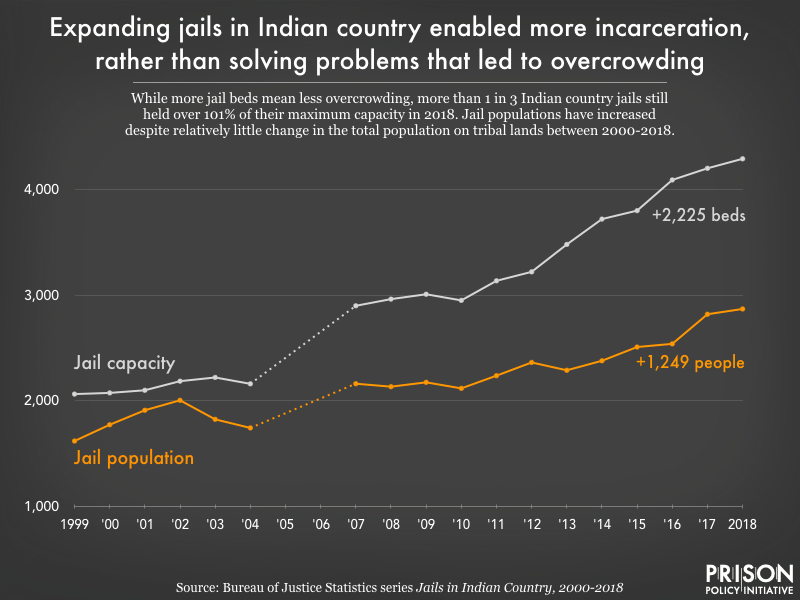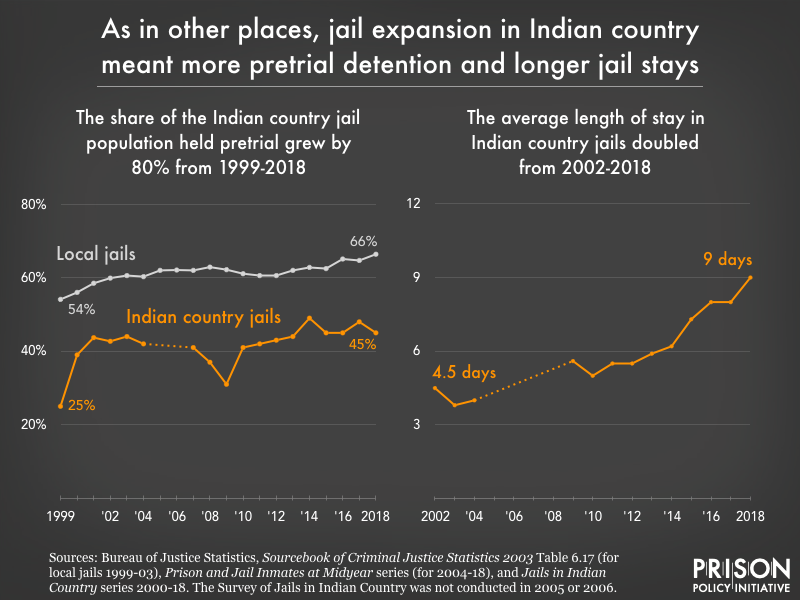New BJS data reveals a jail-building boom in Indian country
Across the country, local governments are building more jail space rather than working to reduce incarceration. New data shows that this trend is especially visible on tribal lands.
by Emily Widra, Wanda Bertram and Wendy Sawyer, October 30, 2020
New data from the Bureau of Justice Statistics shows that the number of jails in Indian country has risen rapidly in recent years, from 68 jails in 2000 to 84 in 2018 (an increase of almost 24%). The number of people in Indian country jails has also grown — by over 1,000 people, or about 60% — even though the total number of people living in these areas has hardly changed.1
The rapid expansion of jail space in Indian country — that is, on tribal lands — holds with a recent nationwide trend. Jail populations have skyrocketed over the past three decades, leading first to overcrowding, and then to sheriffs announcing that they need to build more jails to alleviate overcrowding. But as we’ve previously discussed, while new jails might make existing jails less crowded in the short term, they can enable more incarceration in the long term. And in Indian country, it appears that they have.
As of 2018, 35% of Indian country jails are still holding more people than they were designed for. Compare this number to the 34% of Indian country jails that were above capacity in 2013: The share of overcrowded jails has actually increased slightly over the last several years.2 Only 55 jails in Indian country have populations consistently below their maximum capacity. As the number of jail beds has grown, so has the number of people incarcerated:

Building new jails in Indian country — as in the U.S. in general — enables the criminal justice system to lock up more people for longer periods of time. Most people in jails are being held pretrial; in other words, they are still legally innocent. Indeed, the share of people held pretrial in Indian country jails increased by 20 percentage points (an 80% increase) from 1999 to 2018, and the average length of stay in Indian country jails has doubled since 2002. (At the same time, the share of local jail populations outside of Indian country that are held pretrial has increased by 23% and the average length of stay has stretched by 33%.)

Counties can safely reduce pretrial detention by passing common-sense laws such as money bail reform. On the other hand, allowing pretrial detention to rise by building more jails means that more poor people are separated from their homes, families, and jobs before trial, and subjected to the dangerous conditions of incarceration.
Another startling finding from the report is that for 16% of people in Indian country jails, the most serious charge on which they are held is “public intoxication.” Only about 1.5% of people in U.S. jails in general are held on charges of drunkenness,3 so why is it so much more common in Indian country? Recent studies suggest that the frequency of alcohol consumption among Native Americans is not significantly higher than that of white people or the general population, contrary to stereotypes. But Indian country jails are locking up more people for public intoxication than they do for domestic violence, assault, sexual assault, burglary, larceny, drug offenses, and driving under the influence.
The answer likely has to do with local governments using police and jails to “fix” the problem of people being intoxicated in public, rather than expanding health care and housing to help them get their lives back on track. During the last three decades of jail expansion, jails — particularly in areas where social services are poorly funded — have frequently been used to house people with substance use disorders, including alcohol use, despite the fact that jails are unable to provide effective medical and mental health care to incarcerated people.
There are severe consequences to relying on jails to solve or hide social problems. We know that incarceration can be harmful to individuals and communities, but in Indian country, the effects are even more pronounced:
- Health: Native people are more likely to suffer from chronic illnesses like liver disease, diabetes, and heart disease. Given that jails are not equipped to care for people with long-term illnesses, and that jails themselves are often dangerous environments (with poor food, sanitation, and temperature regulation), the chance that a Native person will die from their illness while incarcerated is serious.4
- Unemployment: The unemployment rate of Native people in the U.S. is 2.7 percentage points higher than that of the general U.S. population. Incarceration — even without a conviction — hinders individuals’ ability to maintain or find employment, compounding the risk of unemployment among Native people.
- Poverty: Native communities are some of the poorest in the U.S.: 1 in 3 Native Americans lives in poverty, and Native people have a poverty rate more than double that of the general population. And incarceration, as we’ve previously reported, only makes people poorer (by keeping them out of the workforce and saddling them with debts).
The recent jail-building boom in Indian country — and nationwide — reflects an unfortunate preference for using police and incarceration to solve problems that stem from inequality. As we explained in our 2019 report Does our county really need a bigger jail?, the right response to a burgeoning jail population is not to build more jail beds, but to reform local criminal justice systems and guarantee people the basic resources (including housing, healthcare, and employment) that they need to succeed.
Footnotes
-
In 2000, there were 944,000 American Indian or Alaskan Native people living in Indian country, according to the U.S. Census. In 2016-2018, there were 939,000, according to the U.S. Bureau of Labor Statistics. ↩
-
These calculations are based on the number of people held on the days in June 2018 and June 2013, respectively, on which the custody population of each facility was the largest, referred to as the “peak population.” ↩
-
This percentage is calculated from data used for our report Mass Incarceration: The Whole Pie 2020. 7,000 people are detained pretrial in jail on charges of “drunkenness/morals” (i.e. that is the most serious charge on which they are being held) and 4,000 are serving a sentence in jail for that same offense. Those 11,000 people make up only 1.5% of all 746,000 people in jails. ↩
-
Given that the death rate for American Indian and Alaska Native people is already 1.3 times higher than the general U.S. population, it is safe to assume that the rate for American Indian and Alaska Native people in jail is even higher than that of non-Native people in jails. ↩



